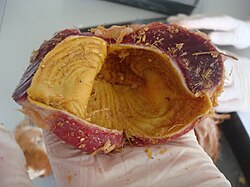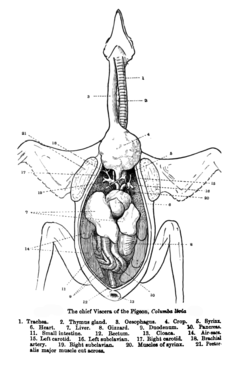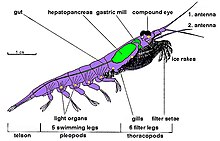กึ๋น
กึ๋น (อังกฤษ: Gizzard) คืออวัยวะที่พบได้ในระบบทางเดินอาหารของสัตว์บางชนิด รวมถึง อาร์โคซอร์ (สัตว์ปีก, ไดโนเสาร์, จระเข้, แอลลิเกเตอร์, เทอโรซอร์), ไส้เดือน, หอยทากบางชนิด, ปลาบางชนิด, สัตว์พวกกุ้งกั้งปูบางชนิด มีกระเพาะอาหารพิเศษที่ ผนังกระเพาะจะมีความหนา ทำหน้าที่ในการบดอาหาร ย่อยเชิงกล โดยตามปกติกล้ามเนื้ออย่างเดียวจะทำงานได้ไม่ดีนัก จึงมักอาศัยความช่วยเหลือจากเศษหินหรือกรวด เข้าไปเพื่อช่วยในการย่อย โดยจะเรียกก้อนกรวดเหล่านี้ว่า แกสโตรลิท หรือหินที่อยู่ภายในลำไส้ ในสัตว์ประเภทแมลง อย่าง แมลงสาบ และ หอยบางชนิด กึ๋น จะมีลักษณะเป็น แผ่นไคติน หรือ ฟัน

ศัพท์มูลวิทยา
คำว่า gizzard มาจากภาษาอังกฤษยุคกลาง giser ซึ่งมาจากคำที่คล้ายกันในภาษาฝรั่งเศสเก่า gésier ซึ่งพัฒนามาจากภาษาลาติน gigeria ซึ่งหมายถึงเครื่องใน[1]
โครงสร้าง


ในสัตว์ปีก
นกจะกลืนอาหารและเก็บไว้ในกระเพาะพักก่อนตามจำเป็น จากนั้นอาหารจะเคลื่อนผ่านไปยัง กระเพาะ glandular หรือเรียกอีกอย่างว่า โปรเวนตริคูลัส บางครั้งก็เรียกว่า กระเพาะอาหารแท้ ซึ่งเป็นส่วนที่ทำหน้าที่ดูดของเหลวในกระเพาะอาหาร ต่อมาอาหารจะเคลื่อนผ่านไปยัง กึ๋น (gizzard) (หรือที่เรียกว่า กระเพาะกล้ามเนื้อ (muscular stomach) หรือ กระเพาะทราย (ventriculus)) กึ๋นสามารถบดอาหารร่วมกับ แกสโตรลิทกรวดที่กลืนเข้าไปก่อนหน้านี้ และส่งกลับไปยังกระเพาะอาหารแท้อได้อีกครั้ง กระบวนการนี้ เปรียบเหมือนกึ๋นทำหน้าที่ เคี้ยว (chews) อาหารให้กับนก เนื่องจากนกไม่มีฟันในการเคี้ยวอาหารเหมือนมนุษย์และสัตว์เลี้ยงลูกด้วยนมชนิดอื่นๆ
By comparison, although in birds the stomach occurs in the digestive tract prior to the gizzard, in grasshoppers the gizzard occurs prior to the stomach, while in earthworms there is only a gizzard, and no stomach.
Koilin lining
In order to protect the muscles of the gizzard, the organ has a multi-layered membrane - or gastric cuticle - made of koilin, a carbohydrate-protein complex (and not keratin as once believed) to protect the muscles.[2] The thickness of this membrane varies with the types of food the animal eats, with diets heavier in grains, seeds, and insects creating thicker membranes than those consisting of fruits, worms, meat, and other softer edibles. In some animals the membrane is slowly worn and replaced over time, while others will discard the worn lining in its entirety periodically.[3]
The lining is critical to the proper functioning of the gizzard, but in some animals it can play an additional role as well. The male hornbill, for example, will fill its gizzard with fruit and then slough off the entire membrane to present it like a 'bag of fruit' to its mate during the nesting season.[3]
Gizzard stones
Some animals that lack teeth will swallow stones or grit to aid in fragmenting hard foods. All birds have gizzards, but not all will swallow stones or grit. Those that do employ the following method of chewing:
A bird swallows small bits of gravel that act as 'teeth' in the gizzard, breaking down hard food such as seeds and thus helping digestion.[4]
These stones are called gizzard stones or gastroliths and usually become round and smooth from the polishing action in the animal's stomach. When too smooth to do their required work, they may be excreted or regurgitated.
Animals with gizzards
Mammals
Pangolins lack teeth and grind their food in a gizzard-like structure.
Birds and other archosaurs
All birds have gizzards. The gizzards of emus, turkeys, chickens, parrots, and ducks are most notable in cuisine (see below). Crocodilians such as alligators and crocodiles also have gizzards.
Dinosaurs that are believed to have had gizzards based on the discovery of gizzard stones recovered near fossils include:
- Psittacosaurus
- Massospondylus
- Sellosaurus
- Omeisaurus
- Apatosaurus
- Barosaurus
- Dicraeosaurus
- Seismosaurus
The belief that Claosaurus had a gizzard has been discredited on the grounds that the fossil remains this claim was based on were another species and the stones merely from a stream.[5]
At least some pterosaurs seemingly had gizzards. The most notable cases are Pterodaustro (inferred via gastroliths) and Rhamphorhynchus (directly preserved).[6][7]
Conversely, it is thought that some extinct birds like Enantiornithes did not have gizzards.[8]
Fish
The mullet (Mugilidae) found in estuarine waters worldwide, and the gizzard or mud shad, found in freshwater lakes and streams from New York to Mexico, have gizzards.The gillaroo (Salmo stomachius), a richly colored species of trout found in Lough Melvin, a lake in the north of Ireland, has a gizzard which is used to aid the digestion of water snails, the main component of its diet.
Crustaceans

Some crustaceans have a gizzard although this is usually referred to as a gastric mill.[9]
Earthworms
Earthworms also have gizzards.[10]
In cuisine

Poultry gizzards are a popular food throughout the world.
Grilled chicken gizzards are sold as street food in Haiti and throughout Southeast Asia. They are considered offal.
Giblets consist of the heart, liver and gizzard of a bird, and are often eaten themselves or used as the basis for a soup or stock.
Gizzard and mashed potato is a popular dish in many European countries.[ต้องการอ้างอิง]
Europe
Stewed gizzards are eaten as a snack in Portugal, with a tomato based sauce.
In Spain, they are cooked on the plancha, and eaten while they are crispy on the outside.
In Hungary, it is made with paprika as zúza pörkölt.
In France, especially the Dordogne region, duck gizzards are eaten in the traditional Périgordian salad, along with walnuts, croutons and lettuce.
In Italy, gizzards are often used mixed with other offal.
In eastern Slavic countries, gizzards are the basis of many soups, such as rassolnik.
In Yiddish, gizzards are referred to as pupik'lech (also pipiklach, in its less normative form), literally meaning navels. The gizzards of kosher species of birds have a green or yellowish membrane lining the inside, which must be peeled off before cooking, as it lends a very bitter taste to the food. In traditional Eastern European Jewish cuisine, the gizzards, necks and feet of chickens were often cooked together, although not the liver, which per kosher law must be broiled. Kosher butchers often sell roasting chickens with the gizzard, neck and feet butchered and left in the cavity to be used for making chicken soup.
Asia
In Indonesia, gizzard and liver (ati ampela) are considered part of a complete fried poultry dish.
In Japan, gizzard is called zuri or sunagimo; usually it is cooked in yakitori (Japanese style skewered barbecue). In Kyushu (southern Japan), gizzard is fried into karaage.
In Korea, chicken gizzard, called dak-ttongjip, is stir-fried and eaten as anju or yasik. In some places, it is prepared raw and eaten mixed with garlic and onion.
In Taiwan, gizzards are often slow-cooked and served hot or cold in slices, with green onions and soy sauce. Skewered deep-fried gizzards without batter are also popular and served on the menu of many fried chicken stores.
In Mainland China, duck gizzard is a common snack, eaten alongside other duck parts such as feet, neck, heart, tongue, or head.[11] Areas famous for their gizzard are Sichuan and Hubei provinces. Wuhan city in Hubei is famous for its brand of spicy gizzard, called jiujiuya (Simplified Chinese:久久鸭). In Northern China, one can find barbecued duck gizzard.
The word sangdana is commonly used to refer to chicken gizzards in Northern India. The word is derived from Persian (sang = stone and dana = grain). Another name is pathri. It may be served cooked in a curry, while barbecued skewered gizzards are also popular.In Kerala, vattum-karulum (literally translates to gizzard-liver curry) is a popular dish.
In Iran, some kebab restaurants mix chicken gizzards in their koobideh kebabs to increase the meat content. Gizzards are usually cooked at the same time along with chicken, packets of gizzards are also sold separately.
In Nepal, gizzard is called jaatey or pangra. It is eaten most often with drinks.
In the Philippines, gizzard is called "Balun Balunan". It is usually cooked as a street food in a skewered barbecue style, though some households treat it like an entree. The most common style is "Adobo".
Africa
In Ghana and Togo, it is eaten boiled, fried or grilled. Grilled, skewered gizzards, with spices and optional green peppers and onions, are popular.
In Nigeria, gizzard is either grilled or fried and served with stew and fried plantain, known as gizdodo.[12] Skewered gizzards are also popular.
In Kenya, Uganda, Cameroon and Nigeria, the gizzard of a cooked chicken is traditionally set aside for the oldest or most respected male at the table.
In Uganda, gizzard and other giblets are now commonly sold separately in the frozen section of supermarkets.
Americas
Pickled turkey gizzards are a traditional food in some parts of the Midwestern United States. In Chicago, gizzard is battered, deep fried and served with french fries and sauce. The Chamber of Commerce in Potterville, Michigan has held a Gizzard Fest each June since 2000; a gizzard-eating contest is among the weekend's events.[13] In the Southern United States, the gizzard is typically served fried, sometimes eaten with hot sauce or honey mustard, or added to crawfish boil along with crawfish sauce, and it is also used in traditional New Orleans gumbo.
In Mexico, they are eaten with rice or with chicken soup. They are also served grilled and prepared scrambled with eggs, onions, garlic and salsa; and served with beans and tortillas for breakfast and other meals.
In Trinidad and Tobago, gizzards are curried and served with rice or roti bread; it can also be stewed.
Generic meaning
The term "gizzards" can also, by extension, refer to the general guts, innards or entrails of animals.[1]
อ้างอิง
การอ้างอิง
General and cited sources
- Solomon, E.P., Berg L.P., and Martin D.W., 2002. Biology Sixth Edition. Thomson Learning Inc., Australia, Canada, Mexico, Singapore, Spain, United Kingdom, United States pp. 664.
- Dyce, Sack, Wensing, 2002. Textbook of Veterinary Anatomy Third Edition, Saunders. ISBN 0-7216-8966-3.